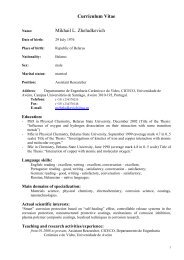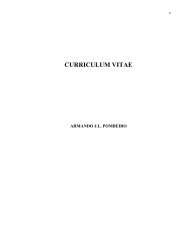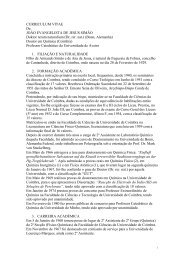XII Iberian Meeting of Electrochemistry XVI Meeting of the ...
XII Iberian Meeting of Electrochemistry XVI Meeting of the ...
XII Iberian Meeting of Electrochemistry XVI Meeting of the ...
You also want an ePaper? Increase the reach of your titles
YUMPU automatically turns print PDFs into web optimized ePapers that Google loves.
<strong>XII</strong> <strong>Iberian</strong> <strong>Meeting</strong> <strong>of</strong> <strong>Electrochemistry</strong> & <strong>XVI</strong> <strong>Meeting</strong> <strong>of</strong> <strong>the</strong> Portuguese Electrochemical Society PL 02<br />
Electron T ransfer in Nanostructures <strong>of</strong> Gold Substrates<br />
Modified with SA M and Gold Nanoparticles.<br />
M. Blázquez, T. Pineda, R. Madueño, D. García-Raya<br />
Departamento de Química Física y T.A., Universidad de Córdoba, Spain<br />
mblazquez@uco.es<br />
Nanoscale charge transfer is important in fundamental science and applications in<br />
molecular electronics including sensors, photonics, electrocatalysis, and solar<br />
photoconversion. Progress in <strong>the</strong> nanoscale charge transfer requires interdisciplinary<br />
collaboration combining a wide range <strong>of</strong> materials syn<strong>the</strong>sis and characterization.<br />
Important classes <strong>of</strong> materials at <strong>the</strong> nanoscale are metal colloids and nanocrystals. The<br />
low dimensions <strong>of</strong> <strong>the</strong>se materials (1-20 nm) confer <strong>the</strong>m unique properties. The ability<br />
to construct well-defined nanostructures by bottom-up approaches is a major goal in <strong>the</strong><br />
field <strong>of</strong> nanoscale science and technology. In recent years, nanoparticles have been <strong>the</strong><br />
subject <strong>of</strong> numerous investigations being widely accepted as ideal building blocks due to<br />
<strong>the</strong> ease <strong>of</strong> preparation and <strong>the</strong> accurate control over particle size and shape. Surface<br />
derivatization schemes have been developed employing self assembled monolayer<br />
(SAM) with special terminating groups which typically induce nanoparticles<br />
organization on <strong>the</strong> surface. The SAM is prepared by <strong>the</strong> spontaneous adsorption <strong>of</strong><br />
molecules from liquid or gas phases producing crystalline or semi-crystalline structures<br />
on <strong>the</strong> substrate surfaces. The high affinity <strong>of</strong> thiol groups to coin metals generates well<br />
organized layers with a variety <strong>of</strong> chemical functions exposed to <strong>the</strong> interface. Many<br />
applications <strong>of</strong> nanoarchitectures require chemical, optical or biological signals to be<br />
transformed into electrical signals that are readable to modern electronic equipment.<br />
Therefore, <strong>the</strong> ability to allow electron communication between nanoparticles and <strong>the</strong><br />
underlying substrate is essential for <strong>the</strong>se applications. In this work we make a revision<br />
<strong>of</strong> several procedures for SAM preparation on Au (111) single crystals. The key point is<br />
<strong>the</strong> preparation <strong>of</strong> defect free SAMs that may show an electron transfer blocking<br />
behavior [1]. We study some strategies for preparation <strong>of</strong> gold nanoparticles <strong>of</strong> different<br />
sizes [2] and characterize <strong>the</strong> properties <strong>of</strong> <strong>the</strong> nanostructured material obtained by <strong>the</strong><br />
combination <strong>of</strong> <strong>the</strong> SAM and nanoclusters on a single crystal substrate<br />
(Au(111)/SAM/AuNP). It can be shown that electron communication between <strong>the</strong><br />
anchored AuNPs and <strong>the</strong> underlying gold substrate occurs through <strong>the</strong> insulating<br />
sandwiched monolayer. Under <strong>the</strong>se conditions, <strong>the</strong> electron transfer occurs by a<br />
tunneling process across <strong>the</strong> bridging molecules. A general discussion <strong>of</strong> <strong>the</strong><br />
electrochemical behavior <strong>of</strong> nanoparticle array electrodes on <strong>the</strong> basis <strong>of</strong> different<br />
surface methods is carried out.<br />
Acknowledgments: Project CTQ2007-62723/BQU (MEC) and Junta de Andalucía<br />
References<br />
[1] García-Raya, D.; Madueño, R.; Blázquez, M; Pineda, T.; J.Phys.Chem. C, 2010, 114, 3568.<br />
[2] Viudez, A. J.; Madueño R.; Pineda, T.; Blázquez, M.; J.Phys.Chem. C, 2006, 110, 17840.<br />
September, 811, 2010. ISEL - Lisbon 13








